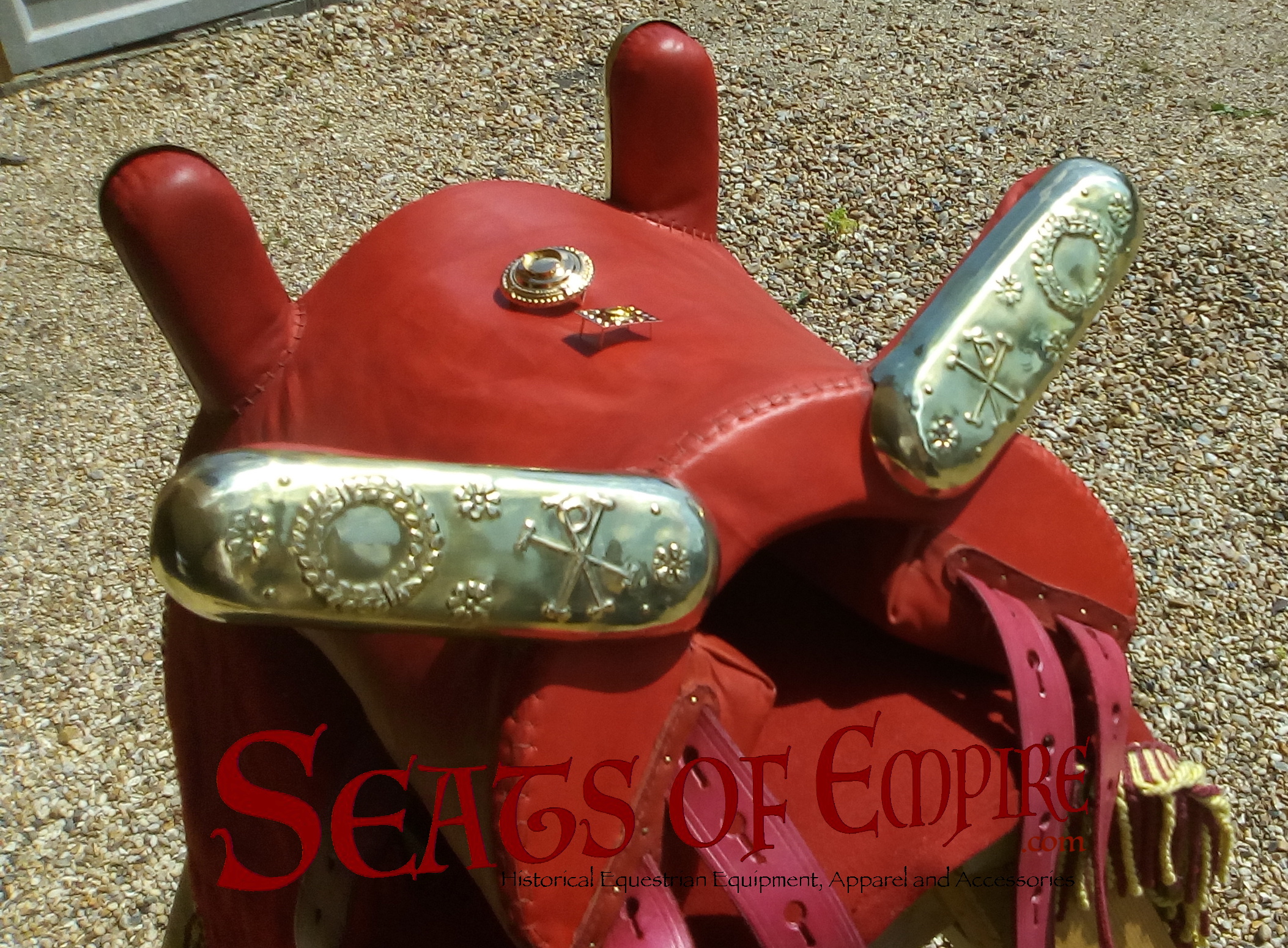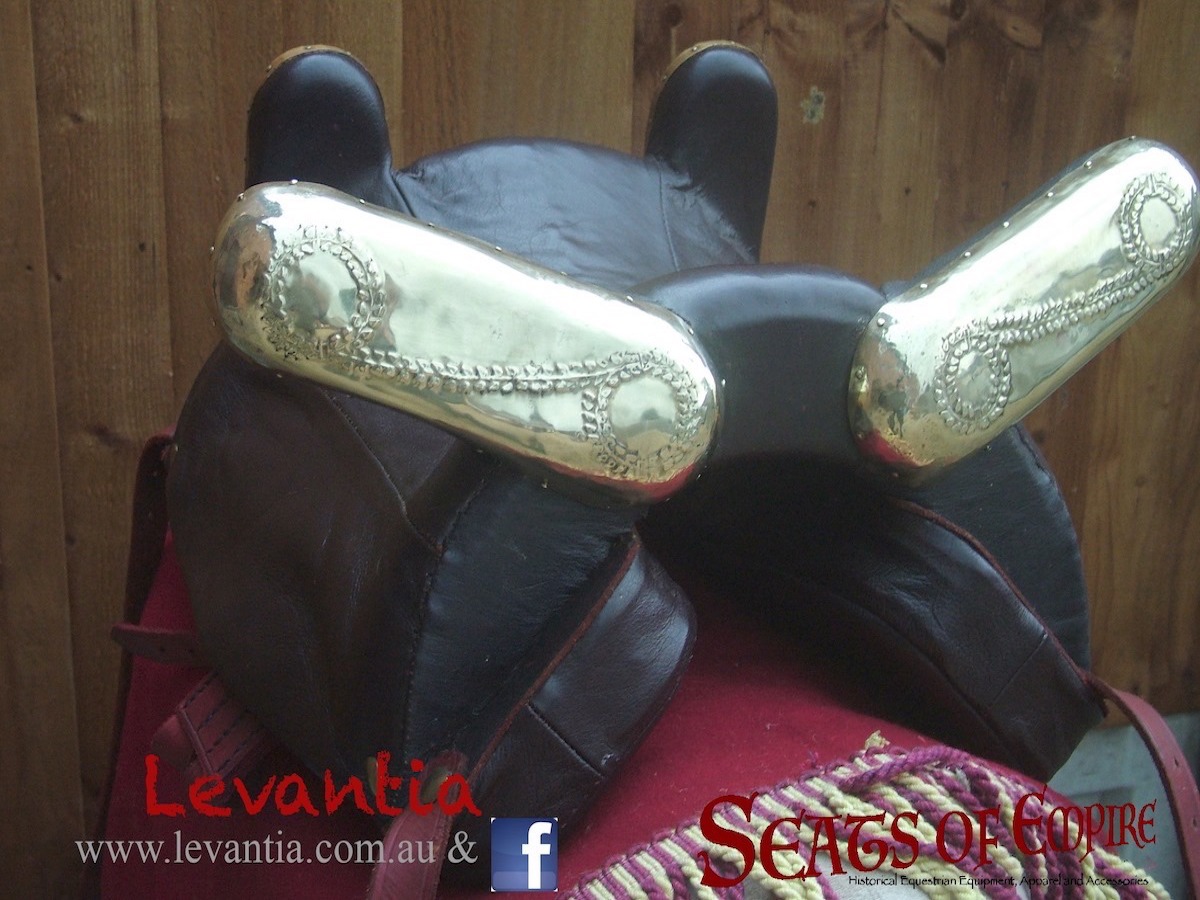Ancient saddles
The point at which horse cloths gave way to shaped saddles is unknown. The scanty evidence suggests that earliest fully shaped saddle was in use in Europe from the second century before the Common Era. Evidence becomes much more prevalent in the first century CE in the Roman Empire, showing four horned saddles, which, despite their lack of stirrups, are highly effective in military use.
The evidence for these saddles is primarily pictorial, but those are supplemented by archaeological finds of leather pieces from saddle coverings, and bronze plates used to face the horns.1 The suggestion that a piece of wood which was recovered in the Millennium Excavations at Carlisle could be an arch from a riding saddle does not bear up under a maker's scrutiny, yet2 recently, excavations of a stable in Pompeii produced some conclusive evidence on the matter, as the skeleton of a horse was found accompanied by a saddle. Preliminary investigation involved sectioning one of the horns which revealed wood inside.
There is a great deal of disagreement about the bronze horn plates and whether they anything more than decorative, or of they did serve a purpose what might have been. A conclusion is hampered by the fact that we have no way of knowing how prevalent they were. A considerable number have been found, but vast quantities of bronze object have been found across the Roman realm, so they should, perhaps, be still more common if they had been needed for the thousands of saddles that must have been made across the empire and over hundreds of years.
To my present knowledge none of the surviving horn plates have complex decoration. Hence, the imperial saddle and pieces below are entirely speculative.

A Roman saddle fit for an Emperor.

Detail of the horn plates of the imperial Roman saddle.
Pommel at left, cantle at right

A plain Roman saddle.

A Roman saddle with moderately decorated horn plates.
The limited quantity and quality of evidence means that any reconstruction of such a saddle demands a lot of conjecture. As a point of fundamental philosophy, it should never be assumed that there was only one way of doing anything, even in a single culture over a limited period, let alone over the vast geographical spread of the earlier Roman Empire, and the hundreds of years until horned saddles were supplanted by stirrup-bearing saddles.
The most copious survivals from Roman saddles are a multitude of copper alloy plates that faced the horns. The function and manner of use of these plates remains obscure, and various theories are energetically debated. Apparently most are plain, but secondary sources mention decoration.

A suitably snug fit for a horned saddle.
More than any other form of saddle, the horned varieties must be proportioned to the rider as well as the horse. A skilled rider will, of course, be able to ride effectively in a loose saddle simply by virtue of per seat, but to get the most benefit from the horns, a close fit is better.

The saddle of an ancient Iranian clibanarius.
The katafraktoi (Greek) or clibanarii (Latin) of ancient Iran (Parthians and Persians - what did they call those troops?) were much more heavily armoured than Roman cavalry of the early imperial era. Riding armoured horses, they took the fight much more directly to the enemy. Hence, their saddles were designed to be even more enclosing and stable than Roman ones, with the front horns being shown in the artworks as arching over to enclose the thighs. Riding on this saddle demands a subtly different leg dynamic than any Roman saddle I have used, and one that is both even more stable and less strenuous. See the Ribchester Roman Festival 2017 page for more on this saddle in use.
Footnotes
- M.C. Bishop, ‘Cavalry Equipment of the Roman Army in the First Century A.D.’, in J.C. Coulston, (ed.), Military Equipment and the Identity of Roman Soldiers, Proceedings of the Fourth Roman Military Equipment Conference, BAR International Series 394, Oxford 1988. Peter Connolly and Carol Van Driel-Murray, ‘The Roman Cavalry Saddle’, Brittannia vol. 22 (1991)
- Howard-Davis, Christine, et al. The Carlisle Millennium Project: Excavations in Carlisle, 1998—2001, vol 2: the finds, Oxford Archaeology North, Lancaster 2009, p. 814.
Copyright: Timothy George Dawson 2022, 2024

